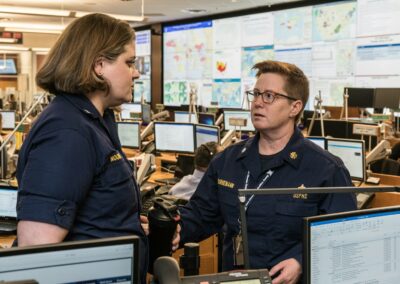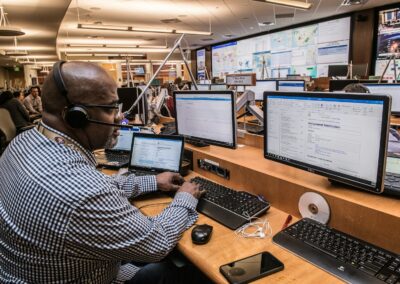Key Challenges in Securing Transportation Networks from Cyber Threats
The Increasing Vulnerability of Transportation Systems
Securing transportation networks from cyber threats has become a critical priority for countries worldwide, including Saudi Arabia, the UAE, Riyadh, and Dubai. As transportation systems become more digitized and interconnected, they face growing vulnerabilities to sophisticated cyber-attacks. These networks, which include aviation, railways, maritime, and public transit, are crucial for economic stability and national security. Cyber-attacks on these systems can lead to severe disruptions, economic losses, and safety risks.
The reliance on digital technologies such as IoT devices, GPS systems, and automated control systems in transportation networks has increased the attack surface for cyber adversaries. For instance, a cyber-attack on an airport’s control system could disrupt flights, affect logistics, and cause significant economic damage. Similarly, attacks on rail or metro systems could halt operations, impacting millions of commuters and businesses.
In regions like the Middle East, where cities such as Riyadh and Dubai are rapidly adopting smart city initiatives, the integration of advanced technologies in transportation systems is accelerating. While these technologies enhance operational efficiency and user experience, they also introduce new cybersecurity challenges. Ensuring the security and resilience of these systems against cyber threats is paramount to maintaining their reliability and safety.
Technological and Operational Challenges
One of the significant challenges in securing transportation networks is the technological complexity and operational diversity of these systems. Transportation networks involve a mix of legacy and modern technologies, making it difficult to implement uniform security measures. Legacy systems, often outdated and less secure, are particularly vulnerable to cyber-attacks, and their integration with newer technologies creates additional security gaps.
Moreover, transportation systems operate in real-time environments where delays or disruptions can have immediate and far-reaching consequences. Implementing robust cybersecurity measures without affecting operational efficiency is a delicate balance. Advanced technologies such as Artificial Intelligence (AI) and machine learning can help enhance cybersecurity by providing real-time threat detection and response capabilities. For example, AI-driven security systems can monitor network traffic, identify anomalies, and respond to threats faster than traditional methods.
Training and awareness among personnel is another critical aspect. Ensuring that staff understand cybersecurity protocols and best practices is essential for preventing human errors that could lead to security breaches. Executive coaching services can play a vital role in developing leadership skills necessary for managing cybersecurity initiatives effectively. Leaders equipped with the right knowledge and skills can drive the implementation of comprehensive cybersecurity strategies across transportation networks.
Regulatory and Compliance Issues
Compliance with regulatory requirements is a significant challenge in the cybersecurity landscape of transportation networks. Governments and regulatory bodies in Saudi Arabia, the UAE, and other regions have established stringent cybersecurity regulations to protect critical infrastructure. Adhering to these regulations requires transportation authorities to adopt comprehensive security frameworks, conduct regular security assessments, and implement industry best practices.
Ensuring compliance involves continuous monitoring and updating of security measures to address evolving threats and regulatory changes. This can be resource-intensive and requires a strategic approach to manage effectively. Organizations must invest in new technologies, update existing systems, and conduct regular audits to ensure compliance with regulatory standards.
In addition to national regulations, international standards and guidelines also play a crucial role in shaping cybersecurity strategies for transportation networks. Collaboration with international bodies and industry associations can help organizations stay informed about the latest regulatory developments and best practices. For regions like the Middle East, where transportation networks are critical to economic growth and development, compliance with global standards is essential for ensuring security and resilience.
Strategies for Enhancing Cybersecurity in Transportation Networks
Implementing Advanced Technologies and Best Practices
To enhance cybersecurity in transportation networks, organizations must adopt advanced technologies and best practices. This includes leveraging AI, machine learning, and blockchain technologies to strengthen security measures. AI and machine learning can improve threat detection and response by analyzing large volumes of data to identify patterns and anomalies indicative of cyber threats.
Blockchain technology can provide additional security by ensuring the integrity and authenticity of data. For example, blockchain can be used to secure communication between different components of transportation systems, preventing unauthorized access and tampering. In regions like Saudi Arabia and Dubai, where smart city projects are rapidly advancing, integrating blockchain into transportation networks can enhance security and operational efficiency.
Regular updates and patches are crucial to address vulnerabilities and prevent exploitation. Automated patch management systems can ensure that all software and hardware components are up-to-date. Continuous monitoring and threat intelligence are essential for staying ahead of emerging threats and adapting security measures accordingly. By implementing these advanced technologies and best practices, transportation networks can enhance their resilience against cyber threats.
Fostering Collaboration and Information Sharing
Collaboration and information sharing are vital for improving cybersecurity in transportation networks. Governments, industry stakeholders, and cybersecurity experts must work together to share threat intelligence, best practices, and lessons learned. Establishing formal information-sharing agreements and participating in industry forums can help organizations stay informed about the latest threats and mitigation strategies.
In the Middle East, initiatives like the UAE’s National Cybersecurity Strategy and Saudi Arabia’s National Cybersecurity Authority emphasize the importance of collaboration between public and private sectors. By fostering a collaborative approach to cybersecurity, these regions can develop more resilient defenses against cyber threats. Information sharing can also help organizations identify common vulnerabilities and implement effective countermeasures.
Executive coaching services can support leaders in navigating the complexities of cybersecurity collaboration. Coaching can help executives develop the skills needed to lead cross-functional teams, build strategic partnerships, and drive cybersecurity initiatives that align with organizational goals. By fostering a culture of collaboration and continuous improvement, organizations can enhance their overall cybersecurity posture.
Building a Cyber-Resilient Culture
Building a cyber-resilient culture is essential for protecting transportation networks from sophisticated cyber threats. This involves promoting cybersecurity awareness and education at all levels of the organization. Regular training sessions, workshops, and simulations can help employees understand the importance of cybersecurity and their role in maintaining it.
Leadership plays a critical role in fostering a cyber-resilient culture. Executives and managers must demonstrate a commitment to cybersecurity by prioritizing investments in security technologies, supporting continuous training programs, and promoting best practices. Executive coaching services can help leaders develop the strategic vision and skills needed to build a cyber-resilient culture within their organizations.
Additionally, organizations should implement comprehensive incident response plans to ensure that they can respond quickly and effectively to cyber-attacks. Regularly testing and updating these plans can help identify gaps and improve readiness. By fostering a culture of preparedness and resilience, organizations can minimize the impact of cyber threats and ensure the continuity of transportation services.
Conclusion
Securing transportation networks from sophisticated cyber threats is a complex and ongoing challenge. For regions like Saudi Arabia, the UAE, Riyadh, and Dubai, investing in advanced technologies, fostering collaboration, and building a cyber-resilient culture are essential steps to protect critical infrastructure. By adopting comprehensive cybersecurity strategies and leveraging the latest technological advancements, organizations can enhance their defenses against emerging cyber threats and ensure the stability and security of their transportation systems.
—
#TransportationNetworkSecurity #CyberThreats #AI #Blockchain #TheMetaverse #ExecutiveCoaching #GenerativeAI #ModernTechnology #BusinessSuccess #LeadershipSkills #ManagementSkills #ProjectManagement #MiddleEastTech #DigitalTransformation #SaudiArabia #UAE #Riyadh #Dubai























